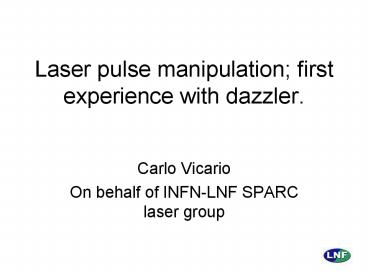Laser pulse manipulation first experience with dazzler' PowerPoint PPT Presentation
1 / 21
Title: Laser pulse manipulation first experience with dazzler'
1
Laser pulse manipulation first experience with
dazzler.
- Carlo Vicario
- On behalf of INFN-LNF SPARC laser group
2
Outlines
- SPARC photocathode driven laser system overview.
- Introduction to AO shaping.
- Dazzler experiment results.
- Other laser group activities.
- Conclusion.
3
Laser requirements for SPARC
4
Pulse shaping
TiSa laser system layout
5
Temporal pulse shaping
- Crucial for low emittance goal.
- Two major techniques AO crystal and liquid
crystal mask.
Courtesy of F. Sakai
J. Appl. Phys. 92, 1608,(2002)
6
Acousto optics programmable dispersive filter
The DAZZLER filter can perform at the same time
phase and amplitude modulation
Eout(w) Ein(w)S(w)
E1(t)
E2(t)
F. Verluise and al, Opt. Lett. 25, 572 (2000).
P. Tournois, Opt. Comm. 140, 245 (1997)
7
We used the Dazzler in double passage
configuration
- Two passages are needed to double the phase
modulation of the filter. - Maximum theoretical pulse length in single pass
is limited to 6 ps by crystal length L - We will discuss also some results in single
passage plus an external dispersion.
8
Dazzler operation conceptual diagram
Trigger from laser
Computer
RF generator
9
Experimental setup for pulse measurements at
Politecnico (Mi)
10
Picture of the apparatus
11
Input pulse time and wavelength domain
measurements
a.u.
ps
100 fs FWHM and 10 nm bandwidth the input pulse
is similar to the expected by SPARC laser
12
Preliminary results
- The transfer function was calculated by
- FFTS(w)FFT-1 algorithm. Feedback from
measurements. - We obtained 10 ps pulse, 0.7 ps rise time and
lt30 p.t.p ripple. - We assumed an ideal dazzler flat response.
13
Improvements to the previous results
Amplitude modulation
- We upgraded the optimal modulation calculation
including selective attenuation. - After few cycles of optimization the pulse
converged to flat top profile. - We obtained reproducible flat top pulse up to 10
ps, less than 20 ripple, and very sharp edges.
Output pulse
14
Single passage test
- The pulse was sent through the crystal once.
- To lengthen the pulse over the crystal limit we
added an external linear chirp by 30 cm of SF57.
15
Single passage output temporal shape
- The shaped pulse is smoother than the 2 passages
results, but still in the rise-time requirements. - Max duration was 7.5 ps. To lengthen the pulse up
to 10 ps a larger external chirp was required.
Output pulses
16
Energy losses measurements for the flat top pulses
- Because the pulse shaper will be placed at low
energy level the amplifier should be able to
recover the losses of the filter. - In both configurations the losses are compatible
with TiSa amplifier requirements (input gt10 mW).
Normal operating area
17
Besides the tests showed some good news
- The dazzler operation was stable for hours (this
result was limited by the source instability). - Laser misalignments of few mrad didnt influence
the pulse shaping. - Dazzler was insensitive to msecond jitters
between acoustic wave and optical pulse.
18
Pulse shaping considerations
- The dazzler will be place at the beginning of the
amplifying chain. - The pulse shaper should pre-compensate the
amplifier and UV conversion distortion. - The pulse shaper should be controlled by a proper
UV diagnostics. - UV cross-correlation seems problematic, sub-ps
streak cameras are expensive systems.
Investigation of down conversion
cross-correlation, Xfrog, Spider etc.
19
Optical transfer line design and experimental
tests are going on.
- The ideal optical system should
simultaneously produce - Wave-front compensation (72 grazing incidence).
- Pointing stability.
- Minimum spherical and chromatic aberrations.
- Minimum environment conditions sensitivity.
- Circular uniform spot on the cathode.
- Square time profile on the cathode.
20
UV optical transfer line to the photocathode
grating
The angular jitters are ok, but the problem is
the gun field-laser synchronization. We will
place the laser in a temperature controlled and
clean environment to increase the stability.
21
Conclusion
- We demonstrated that the Dazzler represents a
promising technique for generation of the
required flat top pulses. - Sensitivity to beam misalignments and energy
losses are compatible with the commercial laser
performances. - Next future we should work further on the pulse
shaper integration with the whole system laser,
diagnostics and optics.

